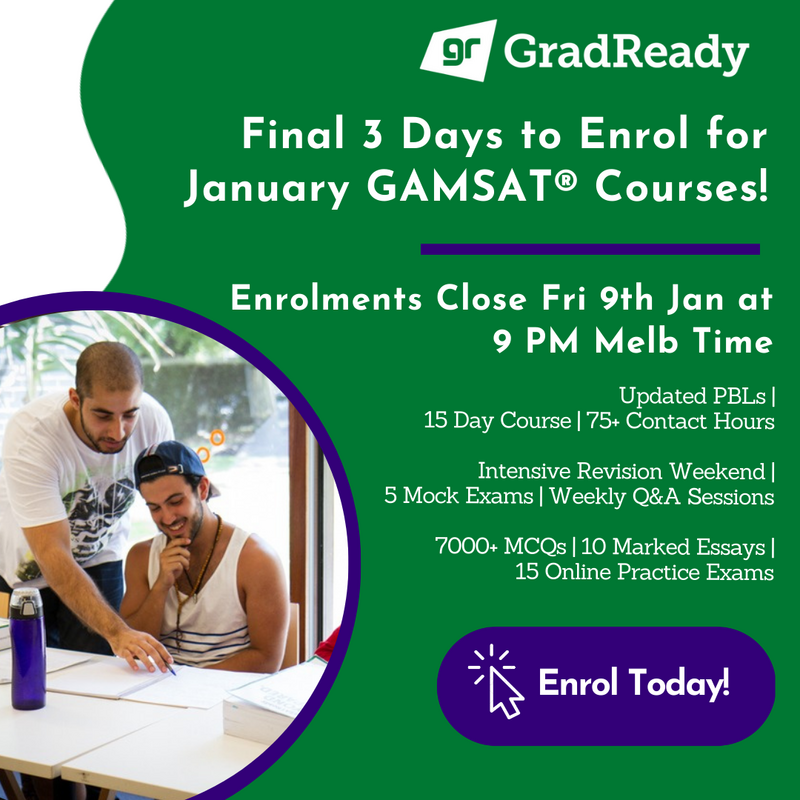The
medical school application process is both a stressful and confusing time in the life of a medical hopeful. Many medical students regard the entire application process (inclusive of the GAMSAT® Exam) as more difficult and nerve-racking than medical school itself!
The purpose of this article is to outline the steps and considerations that you need to go through in submitting your application to medical school. This article will deal specifically with the graduate entry process (following the GAMSAT® Exam) for domestic students at Australian universities.
The material presented here is synthesised from multiple online sources, and through previous medical student application experiences. However, I cannot emphasise enough the importance of thoroughly reading and understanding the official Medicine Applications guide from
GEMSAS, the organisation that facilitates medical graduate admissions for most universities around Australia. The universities themselves are also great resources for the most up-to-date and official information, particularly USyd, Flinders, and Monash, which are not part of GEMSAS, and have a separate application process.
Lastly, as we have come to know all too well, things have been different since 2020. There have been some big (and I mean, things we never thought would be possible) changes to the medical applications process in the past 2 years. If your head is spinning trying to keep up with it all, don’t fear! We’ll cover that here too.
So, many of you will be about to hurdle your way over the big challenge that is the
GAMSAT® Exam, and I wish you all the best. If you’re feeling unsure about what the new GAMSAT® format will involve, we’ve also written a handy article to address
everything you need to know about the GAMSAT® Exam.
Moreover, if you’re like me, and you’re already stressing about what lies ahead, you may be wondering what the whole application-writing process is going to be like.
My first advice is, breathe – you have some
time. Admissions applications close on May 31st. But my second advice is, use that time wisely. This is your opportunity to research what medical school you’d like to attend, and devise your preferences to reflect this. Your choice of medical school can be due to a number of factors, and the following are all very important to consider:
- Geographical location
- School reputation, facilities, services and opportunities
- Social support networks
- Cost of accommodation and living at school location
- Lifestyle of area around school
- How it will impact your options for internship and early career
Of course this is not an exhaustive list, but you should consider a variety of dimensions in selecting a medical school. Remember, this is a personal decision, and will influence where you live for the next four years of your life. Moreover, the state in which you study medicine will be the state where you are (generally) guaranteed an internship, further extending your time in that region. Hence if you really wouldn’t want to live or study somewhere, then it’s probably a good idea not to preference it.
Applicants can list up to six preferences of medical schools, and can indicate what types of offers they would be prepared to accept – such as Commonwealth Supported Place, Bonded, Full Fee Paying, etc.
In 2021, for 2022 entry, the fee for the GEMSAS application is $204. When you’re applying,
GEMSAS calculates your GPA for each of the listed preferences, and then develops a course rank taking into consideration school selection rules which may include any combination of GPA,
GAMSAT® Exam results, and any other selection criteria such as a portfolio score and bonuses. This ranked list is used by schools to make offers for interviews.
When you are ranking your order of universities, you really should have regard to a wide range of issues – and this stage requires a lot of contemplation! Make sure you are fully informed of what is required through the application process as well, such as
how the medical school interview differs between Australian medical schools. For example, if you think you’d do poorly in a group activity, then perhaps don’t preference so highly a university like ANU, which tends to use group scenarios in their interview process. Moreover, if you feel that you can develop a strong portfolio, you may want to preference Uni of Wollongong or Notre Dame high on your list.
Another set of important considerations to make comes from some of the big changes that happened last year –
USyd removed the interview from their application process and consequently offers will be more heavily weighted on GAMSAT® scores. If you are thinking of doing an application for USyd, make sure you read about the changes in their Application
Guide. Other changes for 2022 intake include: UniMelb no longer requiring prerequisite subjects, and now having a rural pathway with a separate application and interview process; in contrast, UQ has
added two prerequisites in cell biology and systems physiology; Uni of Woolongong is no longer using GPA to rank applicants, but instead has a GPA cutoff of 5.5 as a hurdle requirement for interview offers. Furthermore, some universities (UoW, Deakin, UniMelb) will not be using 2020 results in GPA calculations, while UWA will use Semester 2 from 2020 only, and Griffith gives the option of having all semester 1 results from 2020 disregarded.
Applications then close on May 31st, and the
nervous wait begins for the offers for interviews in early September. Interviews then occur around September/October, followed by another nerve-racking wait, and then offers of places for medicine are finally released in early November! The offers are based off rankings similar to the way that interview offers are made (with any combination of GPA, GAMSAT, portfolio, bonuses, interview scores, etc,
depending on the university).
One thing to keep in mind is that you will first be considered for a place offer at the university you interviewed at, and then if not ranked highly enough for an offer there, you can be subsequently considered for offers for places at universities only below that one on your preference list.
Thus, if you don’t get a ‘first round’ offer, not all hope is lost, as throughout December and January additional offers are made to fill vacancies in a ‘second round’ offer, which could be at the university you interviewed at or potentially any that you ranked below that on your preference list! It’s also good to bear in mind that some offers will be conditional on final academic results being maintained above a specified GPA.
Overall, there’s a lot to think about regarding the medical school application process. However, there’s always support out there. If you are still lost about where to start, my recommendation to you would be to thoroughly read the official information (GEMSAS, university websites, etc) and come to an understanding of how different universities may consider you as an applicant. Next, I recommend delving into your aspirations for your studies and considering all the aspects of where you are applying. Lastly, I’d advise that you congratulate yourself for taking this great challenge of navigating the medical applications process, and look forward to your potential future medical studies.
Check out our
GAMSAT To Med School Podcast for more tips & tricks about applying to medical school and information about life at med school.






